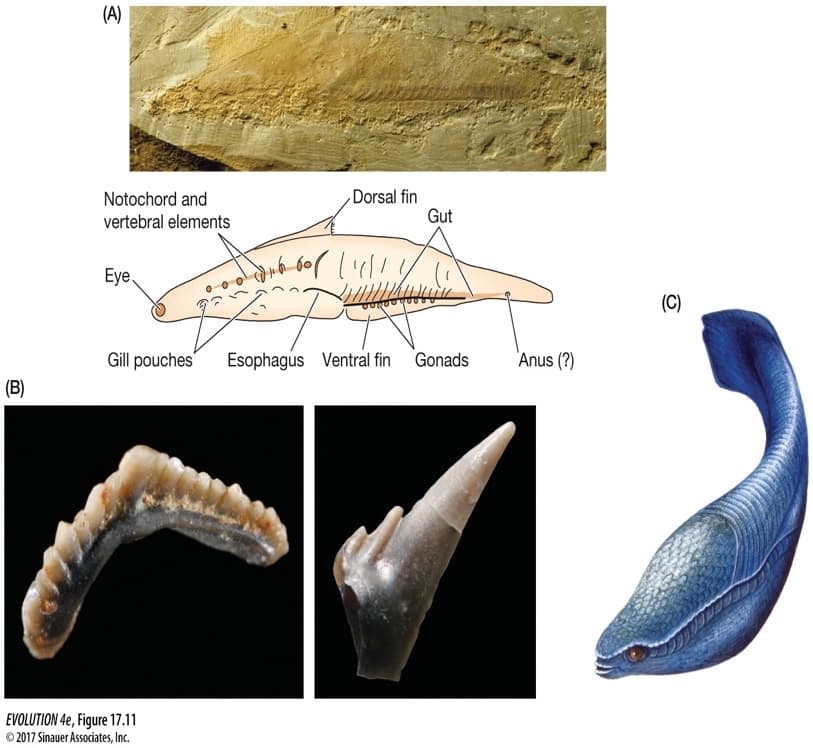anism shown above have that indicate that it is our direct ancestor among the Cambrian fauna? 3. b) When the organism shown above was swimming in the Cambrian seas, it was very small compared to the apex predator (Anomalocaris), which was several feet long. What adaptations might the organism shown above have to evade predation by Anomalocaris? 3. c) A famous evolutionary biologist says that “everything in evolution is contingent”, which he explains means that events could always have turned out differently. Do you think that the survival of our direct ancestor is an example of a lucky accident that allowed the later evolution of vertebrates, including us
anism shown above have that indicate that it is our direct ancestor among the Cambrian fauna? 3. b) When the organism shown above was swimming in the Cambrian seas, it was very small compared to the apex predator (Anomalocaris), which was several feet long. What adaptations might the organism shown above have to evade predation by Anomalocaris? 3. c) A famous evolutionary biologist says that “everything in evolution is contingent”, which he explains means that events could always have turned out differently. Do you think that the survival of our direct ancestor is an example of a lucky accident that allowed the later evolution of vertebrates, including us
Chapter2: Aquatic Plants And Animals
Section: Chapter Questions
Problem 4KA
Related questions
Question
Hello, I need help with number 3 a, b, & c using the diagram below. Pls & thank you!
3. a) What features does the organism shown above have that indicate that it is our direct ancestor among the Cambrian fauna?
3. b) When the organism shown above was swimming in the Cambrian seas, it was very small compared to the apex predator (Anomalocaris), which was several feet long. What adaptations might the organism shown above have to evade predation by Anomalocaris?
3. c) A famous evolutionary biologist says that “everything in evolution is contingent”, which he explains means that events could always have turned out differently. Do you think that the survival of our direct ancestor is an example of a lucky accident that allowed the later evolution of vertebrates, including us? Why or why not?
Photos reference:
Futuyma, D. J., & Kirkpatrick, M. (2017). Chapter 17 The History of Life. In Evolution (4th ed., pp. 430-467). Sunderland, Massachusetts: Sinauer Associates.
![FIGURE 17.11 Cambrian vertebrates. (A) Photo and drawing of one of the earliest
known vertebrates, Haikouichthys, of the early Cambrian. The drawing calls attention
to features that are characteristic of vertebrates. (B) Bony, toothlike structures of Cam-
brian conodonts. Conodonts were slender, finless chordates believed to be related to
agnathans (jawless vertebrates such as lampreys). (C) Reconstruction of a jawless, limb-
less ostracoderm, Arandaspis, as it may have appeared in life. Note the heavy armor
on the front part of the body. Ostracoderm armor has been found in late Cambrian
rocks. (A courtesy of D.-G. Shu, from [84].)](/v2/_next/image?url=https%3A%2F%2Fcontent.bartleby.com%2Fqna-images%2Fquestion%2F65ea5826-21bc-4fd3-a7b6-320e00c383f2%2Fffd64a97-4115-4c59-9337-9277caec408f%2F54f8pj7_processed.jpeg&w=3840&q=75)
Transcribed Image Text:FIGURE 17.11 Cambrian vertebrates. (A) Photo and drawing of one of the earliest
known vertebrates, Haikouichthys, of the early Cambrian. The drawing calls attention
to features that are characteristic of vertebrates. (B) Bony, toothlike structures of Cam-
brian conodonts. Conodonts were slender, finless chordates believed to be related to
agnathans (jawless vertebrates such as lampreys). (C) Reconstruction of a jawless, limb-
less ostracoderm, Arandaspis, as it may have appeared in life. Note the heavy armor
on the front part of the body. Ostracoderm armor has been found in late Cambrian
rocks. (A courtesy of D.-G. Shu, from [84].)

Transcribed Image Text:(A)
Dorsal fin
Gut
Notochord and
vertebral elements
Eye.
(C)
Gill pouches'
Esophagus Ventral fin
Gonads
"Anus (?)
(B)
EVOLUTION 4e, Figure 17.11
© 2017 Sinauer Associates, Inc.
Expert Solution
This question has been solved!
Explore an expertly crafted, step-by-step solution for a thorough understanding of key concepts.
Step by step
Solved in 4 steps

Knowledge Booster
Learn more about
Need a deep-dive on the concept behind this application? Look no further. Learn more about this topic, biology and related others by exploring similar questions and additional content below.Recommended textbooks for you


Biology (MindTap Course List)
Biology
ISBN:
9781337392938
Author:
Eldra Solomon, Charles Martin, Diana W. Martin, Linda R. Berg
Publisher:
Cengage Learning


Biology (MindTap Course List)
Biology
ISBN:
9781337392938
Author:
Eldra Solomon, Charles Martin, Diana W. Martin, Linda R. Berg
Publisher:
Cengage Learning